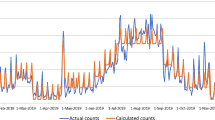Abstract
The analysis task presented here is based on the airports’ landside. The long-term idea is to build a total airport simulation system where microscopic models are used in areas of specific interest and other regions are completed by macroscopic models based e.g. on flow models. Here, the aim is to generate rules describing the passenger flow in the terminal area that can be used for macroscopic models. Fuzzy clustering methods presented in [7,9] enable us to extract in the first step a rule system based solely on available data. The methods used here are able to handle cluster structures of different extensions and to cope with outliers in the data set. Data analysis enables us to identify influence factors that might be underestimated or overlooked by experts.
The result is a rule system that gives us rules in the form “under certain conditions usually an amount of about x % passengers are transfer passengers”. Therefore, the transfer passenger rate is determined in dependence on the flight time, distance to destination, and aircraft size. Although the results represent a good description of the amount of transfer passengers in general, contradictory rules occur in this example. Incorporating expert knowledge in the rule system will be necessary to develop a reliable and consistent description of passenger movements in the terminal
Similar content being viewed by others
References
Ashford N., Stanton HPS., Moore CA. (1997). Airport operations. McGraw Hill, 2nd edn., USA
Bezdek JC. (1981). Pattern recognition with fuzzy objective function algorithms. Plenum Press, New York
Davé RN. (1991). Characterization and detection of noise in clustering. Pattern Recognit Lett 12:657–664
Genther H., Glesner M. (1994). Automatic generation of a fuzzy classification system using fuzzy clustering methods. In: Proceedings of ACM symposium on applied computing (SAC’94), Phoenix, pp. 180–183
Gustafson DE, Kessel WC (1979). Fuzzy clustering with a fuzzy covariance matrix. In: Proceedings IEEE CDC, San Diego pp 761–766
Höppner F., Klawonn F., Kruse R., Runkler T. (1999). Fuzzy cluster analysis. Wiley, Chichester
Keller A. (2000). Fuzzy clustering with outliers. In: Whalen T (eds). PeachFuzz 2000, 19th international conference of the North American Fuzzy Information Processing Society (NAFIPS), Atlanta pp. 143–147
Keller A. (2002). Objective function based fuzzy clustering in air traffic management. URL: http://diglib.uni-magdeburg.de/Dissertationen/2002/anekeller.pdf. Universität Magdeburg Magdeburg Fakultät für Informatik
Keller A., Klawonn F. (2001). Adaptation of cluster sizes in objective function based fuzzy clustering. In: Leondes T (eds). Intelligent systems: techniques and applications. CRC, USA
Klawonn F., Klement E-P. (1997). Mathematical analysis of fuzzy classifiers. In: Liu X., Cohen P., Berthold M (eds). Advances in intelligent data analysis. Springer, Berlin Heidelberg New York, pp. 359–370
Klawonn F., Kruse R. (1995). Automatic generation of fuzzy controllers by fuzzy clustering. In: Proceedings of IEEE Intern. conference on systems, man, and cybernetics, Vancouver, pp. 2040–2045
Klawonn F., Kruse R. (1995). Clustering methods in fuzzy control. In: Gaul W., Pfeifer D (eds). From data to knowledge: theoretical and practical aspects of classification data analysis and knowledge organization. Springer, Berlin Heidelberg New York, pp. 195–202
Klawonn F., Kruse R. (1995). Derivation of fuzzy classification rules from multidimensional data. In: Lasker G., Liu X (eds). Advances in intelligent data analysis, The International Institute for Advanced Studies in Systems Research and Cybernetics. Windsor, Ontario, pp. 90–94
Klawonn F., Kruse R. (1997). Constructing a fuzzy controller from data. Fuzzy Sets Syst 85:177–193
Klee U. (2000). jp Airline-fleets international 2000/01. Bucher & Co, USA
Krishnapuram R., Keller J. (1993). A possibilistic approach to clustering. IEEE Trans. Fuzzy Syst 1:98–110
Kuncheva L. (2000). How good are fuzzy if-then classifiers?. IEEE Trans Syst Man Cybern B 30(4):501–509
Lisin D., Gennert MA. (1999). Optimal function approximation using fuzzy rules. In: Davé RN., Sudkamp T (eds). Proceedings of 18th International Conference North American Fuzzy Information Processing Society. Nafips, New York USA, pp. 184–188
Lufthansa (2001) Lufthansa fleet. URL: http://www.lufthansa financials.de/english/ir/combpany/flotte_b.htm
Mühlhausen T (1999) Ein Beitrag zur makroskopischen Simulation von Passagierströmen zwischen kooperierenden Flughäfen unter Nutzung des SYSTEM DYNAMICS Zuganges nach Forrester (in german) URL: http://hsss.slub-dresden.de/hsss/ servlet/hsss.urlmapping. MappingServlet?993202531468-5970. Technische Universität Dresden Dresden Institut für Verkehrsinformationssysteme
Nürnberger A., Klose A., Kruse R. (1999). Discussing cluster shapes of fuzzy classifiers. In: Davé RN., Sudkamp T (eds). Nafips, New York pp. 546–550
Setnes M., Babuska R., Kaymak U., Lemke HRvN. (1998). Similarity measures in fuzzy rule base simplification. IEEE Trans. Syst Man Cybern B 28(3):376–386
Sugeno M., Yasukawa T. (1993). A fuzzy-logic-based approach to qualitative modelling. IEEE Trans Fuzzy Syst 1:7–31
Takagi T., Sugeno M. (1985). Fuzzy identification of systems and its application to modeling and control. IEEE Trans Syst Man Cybern 15:116–132
Xie XL., Beni G. (1991). A validity measure for fuzzy clustering. IEEE Trans Pattern Anal Mach Intell 13(8):841–847
Yoshinari Y., Pedrycz W., Hirota K. (1993). Construction of fuzzy models through clustering techniques. Fuzzy Sets Syst 54:157–165
Author information
Authors and Affiliations
Corresponding author
Rights and permissions
About this article
Cite this article
Temme, A., Kruse, R. A fuzzy rule system describing transfer passenger movements. Soft Comput 10, 917–923 (2006). https://doi.org/10.1007/s00500-005-0017-7
Published:
Issue Date:
DOI: https://doi.org/10.1007/s00500-005-0017-7




